In heraldry, which is the study of symbols and coats of arms, the royal badges of England are special symbols used by the kings and queens of the Kingdom of England.
Think of a badge like a unique logo for a person or family. It's similar to a coat of arms or a crest, but it's not part of them. Badges are complete on their own. Unlike a coat of arms, which only the owner can display, badges could be worn by many people, like servants or supporters, to show who they worked for or supported. You could see these badges on flags, personal items, and even on buildings to show who owned them or helped pay for them.
The Story of Royal Badges
Royal badges have been used in England for a very long time, since the first days of English heraldry. They are usually simple designs. Many badges were passed down through families or adopted by new rulers. You can still find them in old royal palaces, chapels, and even in some old houses that were connected to the royal family.
One of the earliest royal badges was a sprig of common broom. This plant was said to be worn by Geoffrey of Anjou on his hat. The broom plant, called Plantegenest in old Latin, became Geoffrey's nickname. This led to the name of the Plantagenet family, who ruled England for over 300 years! The Plantagenet kings often used this broom badge, sometimes adding other personal symbols.
- King Henry II used the broom sprig and a golden star-like jewel.
- King Richard I and his brother King John used a star and crescent moon.
- King Henry III used the broom sprig and the star and crescent.
- His son, Edward I, added a golden rose from his mother.
- King Edward II added a golden castle, which he got from his mother, Eleanor of Castile.
It was actually Richard of York, 3rd Duke of York in the 1400s who made the "Plantagenet" name popular for his family. He used it to show his strong connection to Geoffrey and the previous kings during the Wars of the Roses. This name helped his great-grandson, King Henry VIII of England, feel more legitimate as a ruler later on.
Badges became very common during the reign of King Edward III. He used many badges that showed his family history and some new ones he created himself.
Famous Royal Badges
Monarch
(Years Ruled) |
Badges |
Examples |
 House of Plantagenet House of Plantagenet 
(1154–1399) |
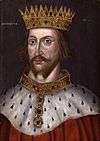
King Henry II
(1154–1189) |
- A golden escarbuncle (a jewel design)
- A sprig of broom or planta genista
|
 |
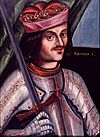
King Richard I
(1189–1199) |
- A golden star and crescent moon
- A sprig of broom
|
  |

King John
(1199–1216) |
- A golden star and crescent moon
- A sprig of broom
|
  |
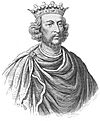
King Henry III
(1216–1272) |
|
 |

King Edward I
(1272–1307) |
- A golden rose with a green stalk
- A sprig of broom
|
  |
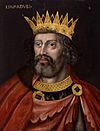
King Edward II
(1307–1327) |
|
 |

King Edward III
(1327–1377) |
- A golden rose with a green stalk
- Sun rays coming from a cloud
- A sprig of broom
- A tree stump (for Woodstock)
- A silver falcon
- A Gryphon (a mythical creature)
- An Ostrich feather (from his wife)
- A golden Fleur-de-lis (for France)
|
     |
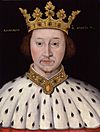
King Richard II
(1377–1399) |
- A sunburst
- A white hart (a male deer) with a golden collar and chain
- A tree stump
- A silver falcon
- A sprig of broom
|
    |
 House of Lancaster House of Lancaster 
(1399–1461) |
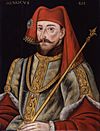
King Henry IV
(1399–1413) |
- The Red rose of Lancaster
- A sun shining brightly
- A rose combined with a sun (Rose en soleil)
- A white swan (from his first wife's family)
- A white antelope
|
     |
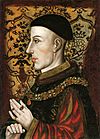
King Henry V
(1413–1422) |
- A silver ostrich feather
- A chained antelope
- A chained swan
- A fire beacon
- The Red rose of Lancaster
|
    |
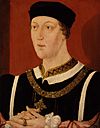
King Henry VI
(1422–1461) |
- A chained antelope
- A chained swan
- A spotted panther
- Two ostrich feathers crossed
- The Red rose of Lancaster
|
    |
 House of York House of York 
(1461–1485) |
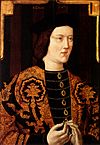
King Edward IV
(1461–1483) |
- A black bull
- A black dragon
- A white lion
- A white wolf
- A white hart
- A silver falcon in a golden fetterlock (a type of lock)
- A sun shining brightly
- The White rose of York
- A rose combined with a sun
|
     |
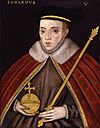
King Edward V
(1483) |
- A silver falcon in a golden fetterlock
- A white rose
|
  |
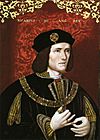
King Richard III
(1483–1485) |
- A white boar
- The White rose of York
- A sun shining brightly
- A white falcon with a virgin's face holding a white rose
|
    |
 House of Tudor House of Tudor 
(1485–1603) |

King Henry VII
(1485–1509) |
- A golden Portcullis (a gate) with a crown
- A white greyhound with a red collar
- A red dragon (from Cadwaladr)
- A crowned hawthorn bush with his initials H.R. (This badge remembers when his crown was found under a hawthorn bush after a battle.)
- The Tudor rose; a red rose with a white rose on top, crowned
|
     |

King Henry VIII
(1509–1547) |
- A golden Fleur-de-lis
- A red dragon
- A white greyhound
- A golden harp with silver strings, crowned (for Ireland)
- A golden portcullis, crowned
- The Tudor rose
- A red rose mixed with a pomegranate (for his first wife, Catherine of Aragon)
|
     |
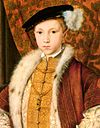
King Edward VI
(1547–1553) |
- A golden Fleur-de-lis
- A red dragon
- A white greyhound
- A golden harp, crowned
- A golden portcullis, crowned
- The Tudor rose
- A red rose, crowned
- A sun shining brightly
|
    |
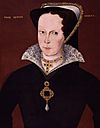
Queen Mary I
(1553–1558) |
- A pomegranate (for her mother, Catherine of Aragon)
- A pomegranate and rose joined together
- The Tudor rose
- A golden harp, crowned
- A golden portcullis, crowned
- A golden Fleur-de-lis
|
   |
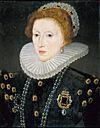
Queen Elizabeth I
(1558–1603) |
- A silver falcon, crowned and holding a scepter (for her mother, Anne Boleyn)
- A crowned Tudor rose with the motto "Rose sine Spina" (Rose without a thorn)
- A phoenix (a mythical bird that rises from ashes)
- A golden harp, crowned
- A golden portcullis, crowned
- A golden Fleur-de-lis
|
    |
 House of Stuart House of Stuart 
(1603–1649) |
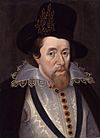
King James I
(1603–1625) |
- The Tudor rose, crowned (for England)
- A thistle, crowned (for Scotland)
- A golden Fleur-de-lis, crowned (for France)
- A rose and thistle combined, crowned (for the Union of the Crowns)
- A golden harp, crowned (for Ireland)
|
     |

King Charles I
(1625–1649) |
- The Tudor rose, crowned (for England)
- A thistle, crowned (for Scotland)
- A golden Fleur-de-lis, crowned (for France)
- A rose and thistle combined, crowned (for the Union of the Crowns)
- A golden harp, crowned (for Ireland)
|
     |
 Time Without a King Time Without a King 
(1649–1660) |
 House of Stuart (Kings Return) House of Stuart (Kings Return) 
(1660–1707) |
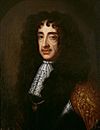
King Charles II
(1660–1685) |
- The Tudor rose, crowned (for England)
- A thistle, crowned (for Scotland)
- A golden Fleur-de-lis, crowned (for France)
- A rose and thistle combined, crowned (for the Union of the Crowns)
- A golden harp, crowned (for Ireland)
|
     |
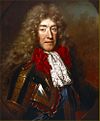
King James II
(1685–1688) |
- The Tudor rose, crowned (for England)
- A thistle, crowned (for Scotland)
- A golden Fleur-de-lis, crowned (for France)
- A rose and thistle combined, crowned (for the Union of the Crowns)
- A golden harp, crowned (for Ireland)
|
     |

King William III and Queen Mary II
(1689–1694) |
- The Tudor rose, crowned (for England)
- A thistle, crowned (for Scotland)
- A golden Fleur-de-lis, crowned (for France)
- A rose and thistle combined, crowned (for the Union of the Crowns)
- A golden harp, crowned (for Ireland)
|
     |
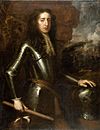
King William III
(1689–1702) |
- The Tudor rose, crowned (for England)
- A thistle, crowned (for Scotland)
- A golden Fleur-de-lis, crowned (for France)
- A rose and thistle combined, crowned (for the Union of the Crowns)
- A golden harp, crowned (for Ireland)
|
     |

Queen Anne
(1702–1707) |
- The Tudor rose, crowned (for England)
- A thistle, crowned (for Scotland)
- A golden Fleur-de-lis, crowned (for France)
- A rose and thistle growing from the same stalk, crowned (for Great Britain)
- A golden harp, crowned (for Ireland)
|
     |
See also


 House of Plantagenet
House of Plantagenet 









































 House of York
House of York 








































 House of Stuart
House of Stuart 












 House of Stuart (Kings Return)
House of Stuart (Kings Return) 































